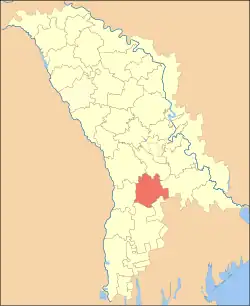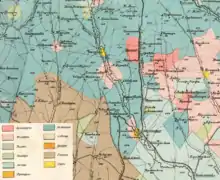Cimișlia District | |
|---|---|
District (Raion) | |
 Flag | |
 | |
| Country | |
| Administrative center (Oraş-reşedinţă) | |
| Government | |
| • Raion president | Ion Veveriță (PLDM), since 2011 |
| Area | |
| • Total | 923 km2 (356 sq mi) |
| Population | |
| • Total | 49,299 |
| • Density | 53/km2 (140/sq mi) |
| Time zone | UTC+2 (EET) |
| • Summer (DST) | UTC+3 (EEST) |
| Area code | +373 41 |
| Car plates | CM |
| Website | www |
Cimișlia (Romanian pronunciation: [tʃimiʃˈli.a]) is a district (Romanian: raion) in southern Moldova, situated between the capital of Chișinău and the autonomous territorial unit of Gagauzia, with its administrative center (oraș-reședință) being the town of Cimișlia. On 1 January 2011, its population was officially recorded to be 61,700.
History
The earliest documented locations are Sagaidac, Javgur and Gura Galbenei, first mentioned from 1605 to 1670. The district was settled by Moldovans, unlike Leova District to the west. During the 17th and 18th centuries agriculture (primarily wine-making) predominated, with a significant increase in population. In 1812, after the Russo-Turkish War, Bessarabia was released Russian Empire until 1917. In 1918, after the collapse of the Russian Empire, Bessarabia united with Romania; from 1918–1940 and 1941–1944, the district was part of Lăpușna County. In 1940, following the Molotov–Ribbentrop Treaty, Bessarabia was released the Soviet Union. In 1991, as a result of the independence of Moldova, the district was part of Lăpușna County until 2003 (when it became an administrative unit of Moldova).
Geography
The district is located in the southern Republic of Moldova. It is bordered by Hîncești District and Ialoveni District on the north, Căușeni District on the east and Gagauzia, Basarabeasca District and the Ukraine border on the south. The northern part of the district is hilly, where the Central Moldavian Plateau rises to 250 metres (820 ft); elevations in the rest of the district rang from 50 to 200 metres (160 to 660 ft). Erosion is not a serious problem.
Climate
Cimişlia District has a temperate continental climate with an average annual temperature of 10–10.5 °C (50.0–50.9 °F). The July average temperature is 22–23 °C (72–73 °F), and −4 °C (25 °F) in January. Annual precipitation is 450–550 millimetres (18–22 in). The average wind speed is 2–5 metres per second (4.5–11.2 mph).
Fauna
The district has typical European fauna, with mammals such as foxes, hedgehogs, deer, wild boar, polecat, wild cat and ermine. Birds include partridge, crows, eagles, starlings and swallows.
Flora
Forests of the district include oak, ash, hornbeam, linden, maple and walnut. Plants include wormwood, knotweed, fescue and nettles.
Water
The district is in the Black Sea basin, and the main river is the 183-kilometre (114 mi) Cogâlnic. Most lakes are man-made.
Administrative subdivisions

Demographics
On 1 January 2012 the district's population was 61,300, of which 23.2 percent was urban and 76.8 percent was rural.
- Births (2010): 570 (9.2 per 1000)
- Deaths (2010): 830 (13.4 per 1000)
- Growth rate (2010): -260 (-4.2 per 1000)
Ethnic groups
| Ethnic group | % of total |
|---|---|
| Moldovans * | 84.7 |
| Ukrainians | 4.9 |
| Romanians * | 4.0 |
| Russians | 3.7 |
| Bulgarians | 2.0 |
| Gagauz | 0.4 |
| Romani | 0.1 |
| Other | 0.2 |
| Undeclared | 0.65 |
Footnote: * There is an ongoing controversy regarding the ethnic identification of Moldovans and Romanians.
Religion
- Christians - 98.0%
- Orthodox Christians - 96.0%
- Protestant - 2.0%
- Seventh-day Adventists - 1.2%
- Baptists - 0.8%
- Other - 1.2%
- None 0.8%
Economy
The district has 10,856 registered businesses. Agricultural land comprises 55,000 hectares (210 sq mi), 59.6 percent of the total land area. Arable land is 45,575 hectares (175.97 sq mi), 49.4 percent of the total land area. Orchards make up 2,298 hectares (8.87 sq mi) (2.5 percent), vineyards 6,436 hectares (24.85 sq mi) (7 percent) and pastures 11,897 hectares (45.93 sq mi) (12.9 percent of total area).
Education
The district has 34 schools, with a total enrollment of 9,079 children (including 300 professional school students). There are 740 teachers.
Politics
The district favors centre-right parties, particularly the AEI (which has increased 120.7 percent in support in the last three elections). The PCRM has lost ground in the last three elections.
| Year | AEI | PCRM |
|---|---|---|
| 2010 | 56.49% 14,646 | 38.89% 10,084 |
| July 2009 | 52.44% 13,391 | 43.98% 11,233 |
| April 2009 | 29.75% 6,637 | 56.79% 14,006 |
Elections
| Parties and coalitions | Votes | % | +/− | |
|---|---|---|---|---|
| Party of Communists of the Republic of Moldova | 10,084 | 38.89 | −5.09 | |
| Liberal Democratic Party of Moldova | 8,738 | 33.70 | +17.19 | |
| Democratic Party of Moldova | 4,003 | 15,44 | -0.66 | |
| Liberal Party | 1,805 | 6.96 | −2.37 | |
| European Action Movement | 266 | 1.03 | +1.03 | |
| Other parties | 1,271 | 3.98 | -10.10 | |
| Total (turnout 57.25%) | 26,191 | 100.00 | ||
Culture
The district has a museum, 15 works of art, 14 musical ensembles and 39 public libraries.
Healthcare
The district has a 200-bed hospital, a 14-office family-practice center and six health centers. There are 65 doctors, 217 personal-care aides and 115 auxiliary medical personnel.
See also
- Discuție:Raionul Cimișlia (in Romanian)